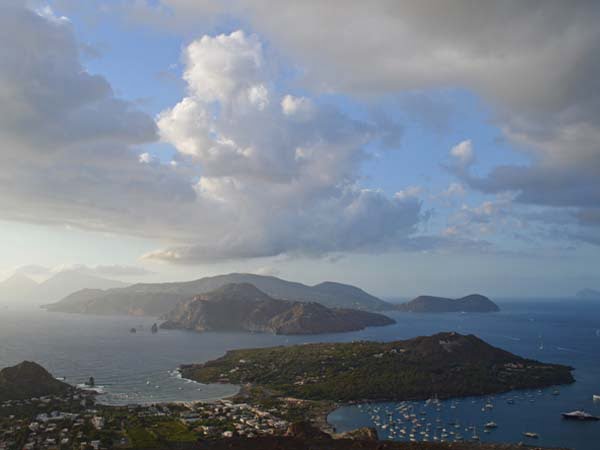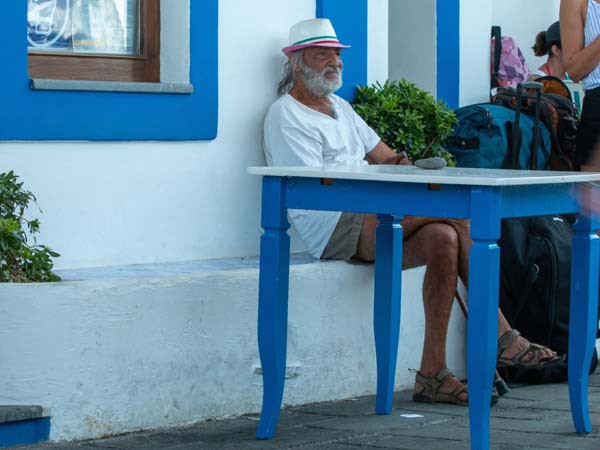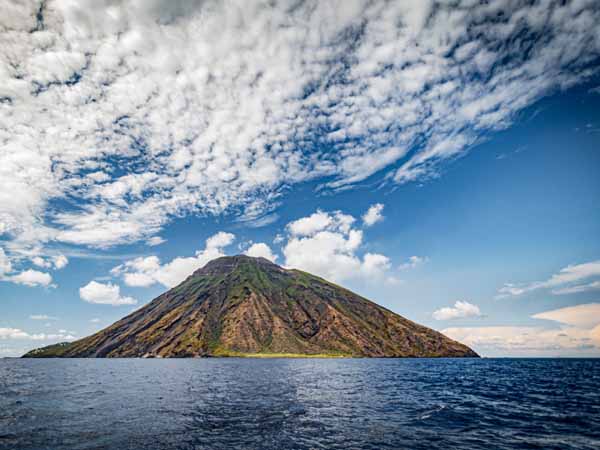Unwinding in Sicily’s Aeolian Islands
North of Sicily, the Seven Pearls of the Mediterranean glisten atop the blue-green waters of the Tyrrhenian Sea. A picturesque archipelago formed by volcanic activity, Italy’s Aeolian Islands are a coastal paradise. Declared a UNESCO World Heritage Site in 2000, the islands of Lipari, Salina, Panarea, Stromboli, Vulcano, Filicudi, and Alicudi collectively offer a haven for travelers to disconnect from the world and immerse in the low-key island lifestyle surrounded by beautiful and untouched natural settings. With charming villages, incredible scenery, and a laidback atmosphere, the Aeolian Islands are the perfect place to relax and commune with nature.
Where are the Aeolian Islands?
Located just north of Sicily and west of Calabria, the seven Aeolian Islands form a “y” in the Tyrrhenian Sea. Named after Aeolus — the “keeper of the winds” in Greek mythology — these rugged islands are the product of more than 200,000 years of volcanic activity.
Today, Stromboli and Vulcano are home to active volcanoes, while secondary volcanic phenomena can be observed on each of the seven islands. The volcanic properties of these islands contribute to their magical atmosphere by offering travelers unique activities, such as snorkeling among Panarea’s underwater fumaroles or watching Mount Stromboli light up the night sky. Fertile volcanic soil is also the key to the pristine nature and agricultural abundance of the islands.
Accessible by boat, the Aeolian Islands are prized for their remote location. While they may be well-known to locals and European tourists, reaching the Aeolian Islands can be trickier for the average international traveler. Thus, advance arrangements are highly recommended in order to offset any potential travel headaches. Trips 2 Italy’s knowledgeable travel specialists can coordinate all details and logistics to ensure that the only thing travelers have to do once they arrive in the Aeolian Islands is relax and enjoy.

Exploring the Aeolian Islands
Though bound by a common history and culture, each island has its own enchanting characteristics that set it apart. Let’s take a moment to get to know these seven gems a little better.

Lipari
As the largest and most populous island in the archipelago, Lipari is considered to be the “main island” of the chain. With plenty of history, monuments, shops, and restaurants, Lipari is an excellent base for families and first-time travelers. Consisting of five ancient villages connected by a scenic road, Lipari is the cultural hub of the islands. Highlights include the breathtaking panoramic views admired from Mount Chirica, the impressive collections of the esteemed Archeological Museum, and the acropolis containing the Gothic Co-Cathedral of San Bartolomeo.
Salina
The second largest island, Salina, provides a nice balance between the bustle of Lipari and the quaint nature of the smaller islands. Without a doubt, travelers come to Salina for the incredible views. In fact, Salina’s Mount Fossa delle Felci, an extinct volcano that stands at more than 3,000 feet, is the highest point in the whole archipelago and offers unbeatable panoramas. The seemingly endless verdant valleys have designated Salina as the greenest of the islands, while the bountiful vineyards, olive groves, and artisanal farms make it a must-stop for lovers of food and wine.


Panarea
Panarea may be the smallest of the seven islands, but what it lacks in size it certainly makes up for in charm and elegance. Thanks to its fashion boutiques and nightlife, Panarea has quickly become a favorite summer destination among the rich and famous. And yet, beneath the modern glitz and glamour lies the old-world charm that is characteristic of the Aeolian Islands. Visitors to Panarea can relax at the hot springs, admire dazzling underwater eruptions, sail to nearby islets, and explore the narrow streets lined with whitewashed houses and artisan workshops.
Stromboli
Best known for the dramatic eruptions of its active volcano, Stromboli is truly a sight to be seen. Conditions permitting, daring travelers can hike to the summit of the volcano or admire the light show and lava flow from a boat off the coast. Continuous volcanic activity has led to striking black sand beaches that are among the best in the archipelago. Other must-sees, besides the volcano, include the captivating Strombolicchio sea stack, the fishing village of Ginostra, and the medieval hamlet of San Vincenzo.


Vulcano
Like Stromboli, Vulcano is renowned for its black sand beaches, also a result of continuous volcanic activity. Fumaroles and underwater steam currents have shaped the island’s truly stunning landscape. For an unforgettable experience, hike up to Gran Cratere to look into the crater of an extinct volcano and admire views of the green surroundings dotted with volcanic ash. Don’t miss the chance to unwind at the open-air sulfur mud baths, which are renowned for their therapeutic properties.
Filicudi and Alicudi
The two remaining islands are the most remote of the archipelago. Largely devoid of the tourism infrastructure found on the other islands, Filicudi and Alicudi are what rustic dreams are made of.
Filicudi, the larger of the two, is home to lovely hiking trails and a handful of little villages that dot the rugged coast. Small pebble beaches resting along crystalline water are the perfect place to relax, while boat rides offer views of striking rock formations and sea caves. Off the coast, divers can explore underwater Ancient Greek and Roman shipwrecks.
Tiny Alicudi’s allure rests in its unspoiled nature, which is the result of few inhabitants and the absence of cars. Without any paved roads, the primary method of transportation here is mule, leaving the island suspended in time. The landscape is notable for its cliffs, terraces, and beaches, though truth be told the defining characteristic of the island is its unwavering tranquility.

Island Activities
The Aeolian Islands offer plenty of things to do both for adventurous travelers as well as those who would simply like to bask in the pristine surroundings.
The untouched cliffs, valleys, and volcanoes of the Aeolian Islands offer the perfect setting for trekking and hiking excursions. From climbing to the top of Stromboli’s active volcano and peering down Vulcano’s expansive crater to admiring craggy rock formations that jut out of the blue waters of the Tyrrhenian Sea, the hiking experiences here are unparalleled. Active travelers may also enjoy mountain biking, snorkeling, diving, kayaking, sailing, and more.
Those who prefer to travel at a slower pace will certainly relish the tranquil lifestyle that’s an integral part of the islands. Between the picture-perfect beaches, relaxing hot springs, and therapeutic sulfur mud baths, the opportunities for relaxation are nearly endless.
Cruising along the coasts is a leisurely way to take in the stunning views these islands are known for from the comfort of a boat. For a dose of history and culture, plan to visit one of the centuries-old churches or Lipari’s Archeological Museum. Small boutiques and artisan workshops that sell handmade leather goods, ceramics, and clothes are scattered throughout the islands, offering the perfect excuse for a shopping break. In the evenings, treat yourself to a sunset dinner with remarkable views of the sea and toast to your dream vacation with a glass of local wine.

Tentalizing food and wine
Like the rest of Italy, the cuisine of the Aeolian Islands is characterized by fresh, seasonal ingredients and simple, yet flavorful, recipes. Due to their remote location, the islands rely on locally farmed products for their cuisine, ensuring that even the most modest dishes are bursting with delectable flavors.
Many fresh ingredients form the foundations of the local cuisine including capers, tomatoes, eggplants, nuts, basil, rosemary, oregano, and goat cheese. Throughout the islands, foodies can indulge in freshly caught seafood paired with organically grown produce straight from the hillside terraces. For an afternoon pick-me-up, indulge in a traditional Sicilian granita, a semi-frozen dessert flavored with local fruits and herbs such as mulberries or mint. Other delicious traditional treats you won’t be able to resist include cannoli and piparelli cookies.
Wine lovers will rejoice with tastings of the sweet Malvasia DOC white wine, the Aeolian Islands’ biggest export. The rich volcanic soil imparts unique notes making the local wine unlike any other in the world. Malvasia delle Lipari DOC is produced exclusively on the seven Aeolian Islands. There is also a passito version, called Passito della Malvasia delle Lipari, made from sun-dried grapes. Local wineries offer tours of their vineyards with wine tastings amid some of the most spectacular panoramas of the Tyrrhenian Sea.
Your home away from home
Accommodations in the Aeolian Islands can be just as varied and distinctive as the islands themselves.
To fully embrace the local lifestyle, consider staying at an agriturismo or countryside estate where you can learn about the delicious products grown and made on the islands directly from the farmers themselves. Those looking for more traditional accommodations will find plenty of options on the larger islands, such as Lipari and Salina. Many hotels have adopted characteristic elements of the local architecture, which consists of whimsical whitewashed, cube-shaped buildings with blue accents and breezy terraces. If boutique hotels or luxury accommodations are your preference, look no further than the chic island of Panarea where you can spend your vacation being pampered in style.
No matter where you choose to stay, your time in the Aeolian Islands will feel like a dream come true.

Outside of typical travel routes, the Aeolian Islands beckon to those seeking a respite from the bustle of daily life. From the rugged landscape characterized by volcanic features, verdant valleys, and rocky cliffs to the unforgettable activities and truly divine food and wine, everything about the Aeolian Islands is enchanting. The only problem is that after spending time in this gorgeous archipelago, you’ll feel the pull to return again and again!
Is Sicily calling your name? Click here to learn more about this fascinating region.
